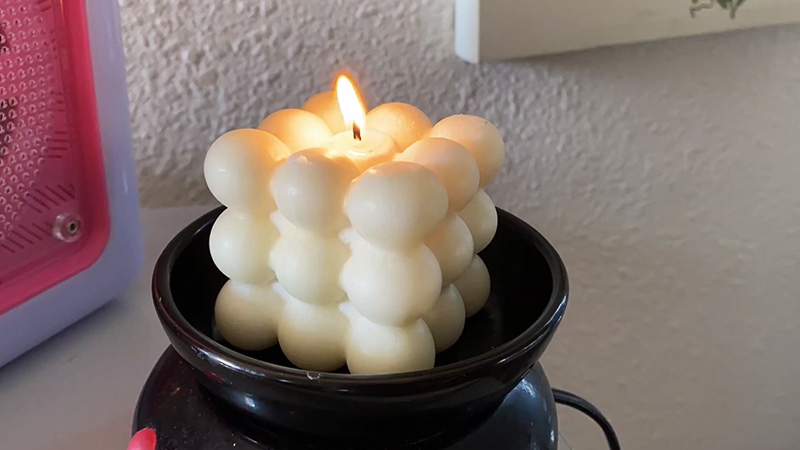Air bubbles in candles can be an unsightly and frustrating problem for candle makers. They can occur for a variety of reasons, including over-stirring the wax, pouring at a lower temperature, or not tapping the glassware gently after pouring the wax.
Additionally, if the vessels are not completely dry before pouring the wax, water residue can cause air bubbles on the surface of the wax. Another common cause of air bubbles in candles is the cooling process of the wax.
If the top of the wax cools and solidifies before the middle, the shrinking of the cooling wax can draw air down the wick, creating cavities or bubbles in the candle.
The purpose of this blog post is to explore the causes of air bubbles in candles and provide tips and techniques for preventing them in order to improve the appearance and overall quality of homemade candles.

Causes of Air Bubbles in Candles
Over-stirring the Wax
When making candles, it’s important to be mindful of how much you’re stirring the wax. Over-stirring can incorporate air into the wax, which can cause bubbles to form when the candle cools and solidifies.
Pouring at a Lower Temperature
Pouring wax that is too cool can also cause bubbles to form. As the wax begins to cool and solidify, the trapped air bubbles will become trapped within the wax and can cause bubbles or cavities on the surface of the candle.
Not Tapping the Glassware Gently After Pouring the Wax
Tapping the glassware gently after pouring the wax can help to release any trapped air bubbles that may have formed during the pouring process.
Water Residue in the Vessels
If the vessels are not completely dry before pouring the wax, water residue can cause air bubbles on the surface of the wax.
Cooling Process of the Wax
Another common cause of air bubbles in candles is the cooling process of the wax. If the top of the wax cools and solidifies before the middle, the shrinking of the cooling wax can draw air down the wick, creating cavities or bubbles in the candle.
These are the common causes of air bubbles in candles and if you could keep these in mind while making candles will help you prevent them.
How to Prevent Air Bubbles in Candles
Avoid Over-stirring the Wax
To prevent air bubbles from forming in the wax, it’s important to avoid over-stirring it. Instead, stir gently and only enough to combine the ingredients.
Pour at a Slightly Hotter Temperature
Pouring the wax at a slightly hotter temperature can help to prevent bubbles from forming as the wax cools and solidifies.
Heat the Containers to 90-100°f in a Warm Oven
Heating the containers before pouring the wax can help to keep the wax from cooling too quickly and solidifying before the bubbles have a chance to rise to the surface.
Tap the Glassware Gently After Pouring the Wax
Tapping the glassware gently after pouring the wax can help to release any trapped air bubbles that may have formed during the pouring process.
Ensure the Vessels Are Completely Dry Before Pouring the Wax
It’s important to ensure that the vessels are completely dry before pouring the wax to prevent water residue from causing air bubbles on the surface of the wax.
By following these tips, you can help to prevent air bubbles from forming in your candles, ensuring that they have a smooth, even surface and burn properly. Remember that making candles is an art and you will have to experiment a little to find the best method for you.
Causes and Prevention Methods of Air Bubbles in Candles
| Causes of Air Bubbles | Prevention Methods |
|---|---|
| Over-stirring the wax | Avoid over-stirring |
| Pouring at a lower temperature | Pour at a slightly hotter temperature |
| Not tapping the glassware gently after pouring the wax | Tap the glassware gently after pouring the wax |
| Water residue in the vessels | Ensure the vessels are completely dry before pouring the wax |
| The cooling process of the wax | Heat the containers to 90-100°F in a warm oven |
FAQs
Yes, you can use other types of wax such as beeswax, paraffin wax, or palm wax to make candles. Each type of wax has its own unique properties and characteristics, so it’s important to research and experiment with different types of wax to find the one that works best for you and your candle-making needs.
You can determine if your candle is fully cooled and solidified by performing a “snap test”. Simply press the side of the candle gently with your finger and listen for a sharp, crisp sound. If the candle makes a snapping sound, it is fully cooled and solidified.
Yes, you can use fragrance oils instead of essential oils in your candles. However, it’s important to note that fragrance oils are synthetic and not natural, while essential oils are derived from plants. Some people prefer to use essential oils in their candles for a more natural fragrance and for therapeutic benefits.
Yes, you can reuse old candle containers for your homemade candles. However, it’s important to thoroughly clean and sanitize the containers before using them again.
Yes, you can make floating candles with soy wax. You will need to use a floating wax, which has a lower density than regular wax, and a wick specifically made for floating candles.
Conclusion
Air bubbles in candles can be a common problem, but by following the prevention methods and tips we’ve provided, you can create candles with a smooth, even surface.
Avoid over-stirring the wax, pour at a slightly hotter temperature, heat the containers, tap the glassware gently, and ensure the vessels are dry before pouring the wax.
Additionally, don’t hesitate to seek out resources and experiment until you find the best methods and techniques for your candle-making journey. With practice and patience, you can create beautiful, high-quality candles.
Leave a Reply